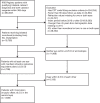IRIS® Registry (Intelligent Research In Sight) Analysis of the Incidence of Monovision in Cataract Patients with Bilateral Monofocal Intraocular Lens Implantation
- PMID: 37877114
- PMCID: PMC10591682
- DOI: 10.2147/OPTH.S424195
IRIS® Registry (Intelligent Research In Sight) Analysis of the Incidence of Monovision in Cataract Patients with Bilateral Monofocal Intraocular Lens Implantation
Abstract
Purpose: To determine the incidence of pseudophakic monovision among patients bilaterally implanted with monofocal intraocular lenses (IOLs) and to characterize the distribution of myopic offsets achieved.
Patients and methods: This retrospective database study included data on patients receiving care from ophthalmologists who contributed to the Academy IRIS® (Intelligent Research In Sight) Registry. Anonymized data were collected, including patient age, ethnicity, procedure data (CPT code, date, laterality), and postoperative manifest refractive spherical equivalent (MRSE) in both eyes implanted with monofocal or monofocal toric IOLs. No data regarding IOL manufacturer, model, or power were collected. One primary outcome measure was the percentage of patients achieving monovision (defined as emmetropia within ±0.25 diopters [D] in one eye and a myopic offset of ≥0.50 D in the fellow eye) among all patients receiving bilateral monofocal IOLs at the time of cataract surgery between January 1, 2016, and September 1, 2019, with at least 90 days of follow-up. Other primary outcomes included the distribution and frequency of myopic offsets (anisometropia) between eyes.
Results: Of the 16,765 people receiving bilateral monofocal IOLs within the study period, 4796 (28.6%) achieved emmetropia in at least one eye, as defined by an MRSE within ± 0.25 D. The incidence of monovision among these patients was 34.2% (1638/4796). One-quarter (24.7%; 405/1638) of patients who achieved monovision had a myopic offset between 0.50 and 0.74 D, with more than one-third (35.2%; 576/1638) falling within 0.75-1.24 D and 18.0% within 1.25-1.74 D. A myopic offset ≥1.75 D was observed in 22.1% (362/1638) of patients who achieved monovision.
Conclusion: Pseudophakic monovision for presbyopia correction was achieved in ~34% of patients in the IRIS Registry bilaterally implanted with monofocal IOLs, with myopic offsets typically ranging from 0.5 to 1.24 D.
Keywords: diopter correction; monofocal IOLs; monovision; myopic offset; presbyopia.
© 2023 Bafna et al.
Conflict of interest statement
Dr Shamik Bafna is a key opinion leader for Alcon, Zeiss, and BVI, outside the submitted work. Mrs Helene Fevrier is an employee of Verana Health which was contracted to perform these analyses. Dr Xiaolin Gu and Dr Mohinder Merchea are employees of Alcon Vision, LLC. The authors report no other conflicts of interest in this work.
Figures
Similar articles
-
Comparison of visual performances of enhanced monofocal versus standard monofocal IOLs in a mini-monovision approach.BMC Ophthalmol. 2023 Apr 21;23(1):170. doi: 10.1186/s12886-023-02920-6. BMC Ophthalmol. 2023. PMID: 37085852 Free PMC article.
-
Phakic intraocular lenses for the treatment of refractive errors: an evidence-based analysis.Ont Health Technol Assess Ser. 2009;9(14):1-120. Epub 2009 Oct 1. Ont Health Technol Assess Ser. 2009. PMID: 23074518 Free PMC article.
-
Visual outcomes, spectacle independence, and patient satisfaction of pseudophakic mini-monovision using a new monofocal intraocular lens.Sci Rep. 2022 Dec 15;12(1):21716. doi: 10.1038/s41598-022-26315-7. Sci Rep. 2022. PMID: 36522397 Free PMC article.
-
The Quest for Spectacle Independence: A Comparison of Multifocal Intraocular Lens Implants and Pseudophakic Monovision for Patients with Presbyopia.Semin Ophthalmol. 2017;32(1):111-115. doi: 10.1080/08820538.2016.1228400. Epub 2016 Oct 28. Semin Ophthalmol. 2017. PMID: 27792408 Review.
-
Toric intraocular lens versus limbal relaxing incisions for corneal astigmatism after phacoemulsification.Cochrane Database Syst Rev. 2019 Dec 17;12(12):CD012801. doi: 10.1002/14651858.CD012801.pub2. Cochrane Database Syst Rev. 2019. PMID: 31845757 Free PMC article.
Cited by
-
Outcomes of mini-monovision with monofocal, enhanced monofocal and extended depth-of-focus intraocular lenses.Front Med (Lausanne). 2025 Feb 21;12:1522383. doi: 10.3389/fmed.2025.1522383. eCollection 2025. Front Med (Lausanne). 2025. PMID: 40061383 Free PMC article. Review.
-
A comparative study of mini-monovision, crossed mini-monovision, and emmetropia with enhanced monofocal intraocular lenses.Sci Rep. 2025 Jan 6;15(1):916. doi: 10.1038/s41598-024-80663-0. Sci Rep. 2025. PMID: 39762240 Free PMC article.
-
Presbyopia Correction in Lens Replacement Surgery: A Review.Clin Exp Ophthalmol. 2025 Aug;53(6):668-681. doi: 10.1111/ceo.14535. Epub 2025 Apr 28. Clin Exp Ophthalmol. 2025. PMID: 40295166 Free PMC article. Review.
References
LinkOut - more resources
Full Text Sources



